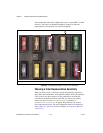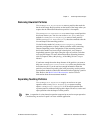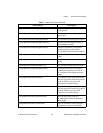
© National Instruments Corporation 4-1 IMAQ Vision for Visual Basic User Manual
4
Performing Particle Analysis
This chapter describes how to perform particle analysis on the images. Use
particle analysis to find statistical information about particles, such as the
presence, size, number, and location of particle regions. With this
information, you can perform many machine vision inspection tasks, such
as detecting flaws on silicon wafers or detecting soldering defects on
electronic boards. Examples of how particle analysis can help you perform
web inspection tasks include locating structural defects on wood planks or
detecting cracks on plastic sheets.
Figure 4-1 illustrates the steps involved in performing particle analysis.
Figure 4-1. Steps for Performing Particle Analysis
Create a Binary Image
Threshold the grayscale or color image to create a binary image. Creating
a binary image separates the objects that you want to inspect from the
background. The threshold operation sets the background pixels to 0 in the
binary image, while setting the object pixels to a non-zero value. Object
pixels have a value of 1 by default, but you can set the object pixels to any
value or retain their original value.
You can use different techniques to threshold the image. If all the
objects of interest in the grayscale image fall within a continuous range
of intensities and you can specify this threshold range manually, use
CWIMAQVision.Threshold to threshold the image.
Create a Binary Image
Improve a Binary Image
Make Particle Measurements
in Pixels or Real-World Units


















